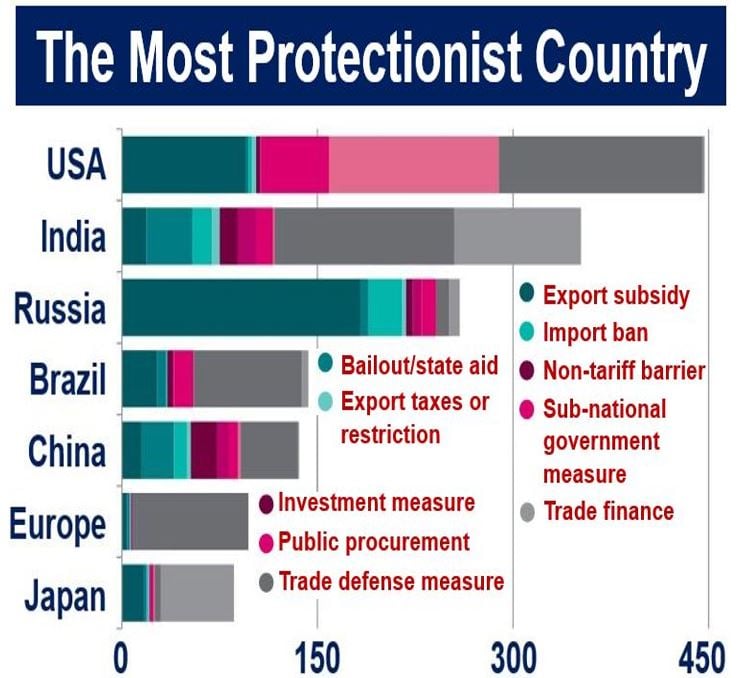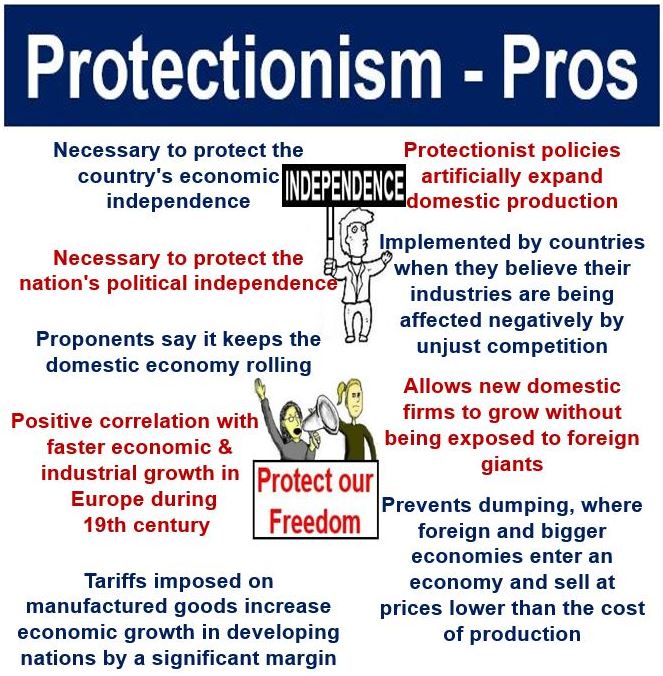Protectionism is an attempt by a country’s leaders to restrict imports or promote exports. They do this by imposing tariffs, quotas, and introducing other barriers to trade. Protectionism is the opposite of free trade. Free trade is international trade which follows its natural course without quotas, tariffs, or other restrictions.
As international trade continues to expand, economists across the world warn about the dangers of protectionism.
20th-century leaders had hoped that protectionism would protect their economies. However, their policies had the opposite effect, i.e., they undermined GDP growth. GDP stands for Gross Domestic Product.
Free trade policies were more successful in promoting GDP growth than protectionism during the 20th century.
This was not the case, however, during the 18th and 19th centuries. During the 18th and 19th centuries, Europe benefited enormously from protectionism.
The most popular methods of protectionism include quotas and tariffs on imports. Tax cuts or subsidies for domestic companies are also protectionist measures.
Tariffs are taxes or duties that the government levies on imports. A quota is a trade restriction that limits the monetary value or number of imports.
Reasons for Protectionism
Some leaders may favor protectionism for the following reasons:
– They want to reduce the trade deficit. If a country imports more than it exports it has a trade deficit. In other words, they want to intervene to either reduce a trade deficit or turn it into a surplus.
– The government wishes to protect or recover job numbers in certain sectors.
– To promote the growth of specific domestic industries.
Over the past decade, protectionism has become a common theme for the anti-globalization movement.
The anti-globalization movement is against large, multinational corporations having unregulated economic and political power. Multinationals have become powerful as a result of financial market deregulation and trade agreements.
Protectionism measures
Governments have a wide array of economic, financial and administrative weapons at their disposal to achieve their protectionist goals:
Tariffs
These are taxes and duties governments levy on imports. Rates vary, depending on the import. For example, tobacco and alcoholic drinks typically have high tariffs. Educational books and infant milk powder, on the other hand, usually have no import taxes.
Import tariffs push up the cost to importers and raise the price of their goods in local markets. This subsequently favors domestic suppliers.

Preferential Government Spending
All government departments may have orders to purchase goods and services only from domestic suppliers.
Quotas
The quota’s aim is to reduce the total number of imports or their monetary value by imposing a limit.
Political Campaigns
The government could finance a propaganda program to try to persuade consumers to buy domestic goods and services.
However, unless domestic companies produce excellent quality goods, this measure does not usually work.
Administrative Barriers
The protectionist country can drown the importer in an ocean of red tape, rules, and regulations.
Anti-dumping regulations
The importer may accuse the foreign supplier of dumping. Dumping means exporting something at cost or below cost prices. Dumping is a strategy to destroy competitors abroad or gain market share internationally. It may also be a strategy to protect jobs.
Exchange Rate Controls
The government or its central bank may artificially reduce the value of its currency. Subsequently, exports become cheaper and imports more expensive.
This policy only works over the short-term, because a cheaper currency usually precedes higher inflation.
Export subsidies
The government gives money to exporters to reduce the price of exports.
Direct Subsidies
The government gives money to the domestic suppliers. Specifically, the government targets domestic suppliers that are struggling in the global market.
 The vast majority of economists say that protectionism, over the long term, is bad for the country that imposes it. It is also bad for that country’s people.
The vast majority of economists say that protectionism, over the long term, is bad for the country that imposes it. It is also bad for that country’s people.
Protectionism in the United States
The United States appears to be closing a 2-centuries-old circle which started with the Tariff of 1816 and ended in 1945. It now appears to be starting again with President Trump. From 1816 to the end of World War II (1945), America had a de facto protectionist policy.
In 1945, when World War II wiped out its major competitors, the US opened up to a free trade policy.
Since becoming President, Donald Trump appears to be raising that protectionist wall again.
 US Presidents Theodore Roosevelt (1858-1919), William McKinley (1843-1901) and Abraham Lincoln (1809-1865) were strong advocates of protectionism. So was George Washington (1732-1799).
US Presidents Theodore Roosevelt (1858-1919), William McKinley (1843-1901) and Abraham Lincoln (1809-1865) were strong advocates of protectionism. So was George Washington (1732-1799).
Economic commentators say that President Trump will not be able to raise the walls of protectionism for several reasons:
Retaliation
If he did, other countries would retaliate. It would soon become clear that the US would suffer enormously in an international trade war. Especially if that trade war were with the rest of the world.
Consequently, President Trump would change his mind and back off.
The Republican Party
President Trump represents a party that believes strongly in the market economy. The market economy includes free trade. Therefore, many lawmakers in his own party will try to stop him from going ahead with a protectionist policy.
Automation
President Trump made a promise during his election campaign that he will be unable to keep. Many of his voters were blue-collar workers from America’s Rust Belt. He told them that their jobs had gone abroad.
He said that he would bring them back with import tariffs and other protectionist measures.

Alan Greenspan is an American economist who was Chairman of the Federal Reserve of the United States from 1987 to 2006. He has the second-longest Fed tenure in US history, behind William McChesney Martin (1906-1998). In February 2007, he forecast a possible recession in the US either before or in early 2008. Within a day of making that comment, the Dow Jones Industrial Average lost 3.3% of its value – falling 416 points. (Image: thefamouspeople.com)
What Trump did not tell them was that most manufacturing jobs in America have been disappearing because of automation. Some jobs have gone abroad, but that was a problem a couple of decades ago.
Automation is advancing at breakneck speed, and there is nothing he can do about that. The Rust Belt is not only an American problem – it is a global one.
No matter how much he embraces protectionism, President Trump will not be able to bring back those jobs.
Even in Germany, Japan, and China, blue-collar manufacturing jobs are disappearing because of automation (robots).
Import Substitution Industrialization
During the 20th century, many developing and emerging economies pursued Import Substitution Industrialization or ISI.
ISI advocated replacing imports with domestic production. It was a protectionist policy which mainly died out during the 1980s and 1990s.
Video – Why enact protectionism?
If most economists say free trade is better for a country’s economy, why are there nations erecting barriers and embracing protectionism?
This Mindlever Education Center video explains why certain governments have decided to restrict imports.
